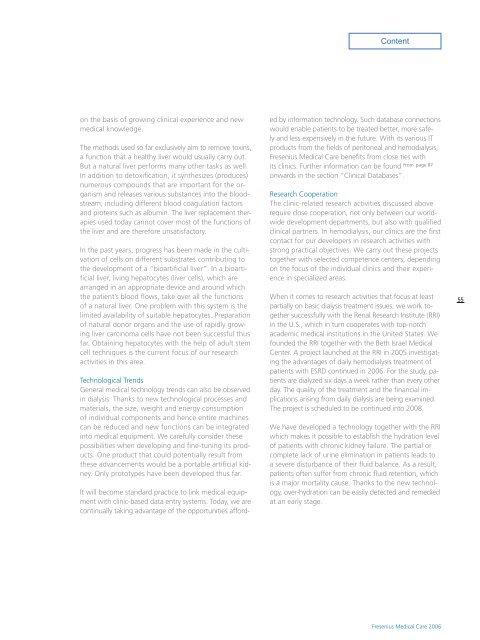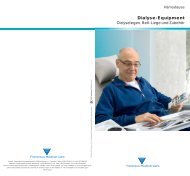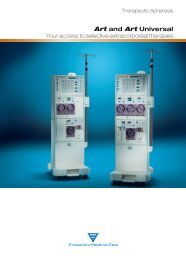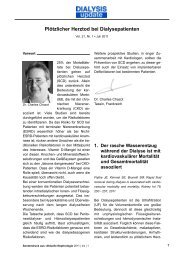Operations and Business Environment - Fresenius Medical Care
Operations and Business Environment - Fresenius Medical Care
Operations and Business Environment - Fresenius Medical Care
You also want an ePaper? Increase the reach of your titles
YUMPU automatically turns print PDFs into web optimized ePapers that Google loves.
on the basis of growing clinical experience <strong>and</strong> new<br />
medical knowledge.<br />
The methods used so far exclusively aim to remove toxins,<br />
a function that a healthy liver would usually carry out.<br />
But a natural liver performs many other tasks as well.<br />
In addition to detoxification, it synthesizes (produces)<br />
numerous compounds that are important for the organism<br />
<strong>and</strong> releases various substances into the bloodstream,<br />
including different blood coagulation factors<br />
<strong>and</strong> proteins such as albumin. The liver replacement therapies<br />
used today cannot cover most of the functions of<br />
the liver <strong>and</strong> are therefore unsatisfactory.<br />
In the past years, progress has been made in the cultivation<br />
of cells on different substrates contributing to<br />
the development of a “bioartificial liver”. In a bioartificial<br />
liver, living hepatocytes (liver cells), which are<br />
arranged in an appropriate device <strong>and</strong> around which<br />
the patient’s blood flows, take over all the functions<br />
of a natural liver. One problem with this system is the<br />
limited availability of suitable hepatocytes. Preparation<br />
of natural donor organs <strong>and</strong> the use of rapidly growing<br />
liver carcinoma cells have not been successful thus<br />
far. Obtaining hepatocytes with the help of adult stem<br />
cell techniques is the current focus of our research<br />
activities in this area.<br />
Technological Trends<br />
General medical technology trends can also be observed<br />
in dialysis. Thanks to new technological processes <strong>and</strong><br />
materials, the size, weight <strong>and</strong> energy consumption<br />
of individual components <strong>and</strong> hence entire machines<br />
can be reduced <strong>and</strong> new functions can be integrated<br />
into medical equipment. We carefully consider these<br />
possibilities when developing <strong>and</strong> fine-tuning its products.<br />
One product that could potentially result from<br />
these advancements would be a portable artificial kidney.<br />
Only prototypes have been developed thus far.<br />
It will become st<strong>and</strong>ard practice to link medical equipment<br />
with clinic-based data entry systems. Today, we are<br />
continually taking advantage of the opportunities afford-<br />
ed by information technology. Such database connections<br />
would enable patients to be treated better, more safely<br />
<strong>and</strong> less expensively in the future. With its various IT<br />
products from the fields of peritoneal <strong>and</strong> hemodialysis,<br />
<strong>Fresenius</strong> <strong>Medical</strong> <strong>Care</strong> benefits from close ties with<br />
its clinics. Further information can be found<br />
from page 87<br />
onwards in the section “Clinical Databases”.<br />
Research Cooperation<br />
The clinic-related research activities discussed above<br />
require close cooperation, not only between our worldwide<br />
development departments, but also with qualified<br />
clinical partners. In hemodialysis, our clinics are the first<br />
contact for our developers in research activities with<br />
strong practical objectives. We carry out these projects<br />
together with selected competence centers, depending<br />
on the focus of the individual clinics <strong>and</strong> their experience<br />
in specialized areas.<br />
When it comes to research activities that focus at least<br />
partially on basic dialysis treatment issues, we work together<br />
successfully with the Renal Research Institute (RRI)<br />
in the U.S., which in turn cooperates with top-notch<br />
academic medical institutions in the United States. We<br />
founded the RRI together with the Beth Israel <strong>Medical</strong><br />
Center. A project launched at the RRI in 2005 investigating<br />
the advantages of daily hemodialysis treatment of<br />
patients with ESRD continued in 2006. For the study, patients<br />
are dialyzed six days a week rather than every other<br />
day. The quality of the treatment <strong>and</strong> the financial implications<br />
arising from daily dialysis are being examined.<br />
The project is scheduled to be continued into 2008.<br />
We have developed a technology together with the RRI<br />
which makes it possible to establish the hydration level<br />
of patients with chronic kidney failure. The partial or<br />
complete lack of urine elimination in patients leads to<br />
a severe disturbance of their fluid balance. As a result,<br />
patients often suffer from chronic fluid retention, which<br />
is a major mortality cause. Thanks to the new technology,<br />
over-hydration can be easily detected <strong>and</strong> remedied<br />
at an early stage.<br />
55<br />
<strong>Fresenius</strong> <strong>Medical</strong> <strong>Care</strong> 2006








